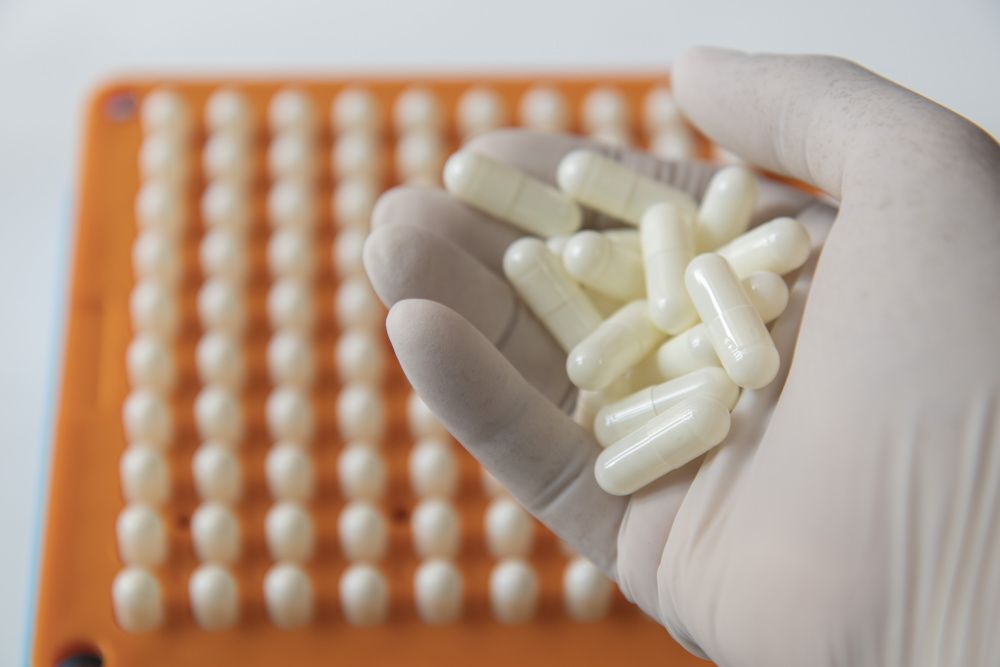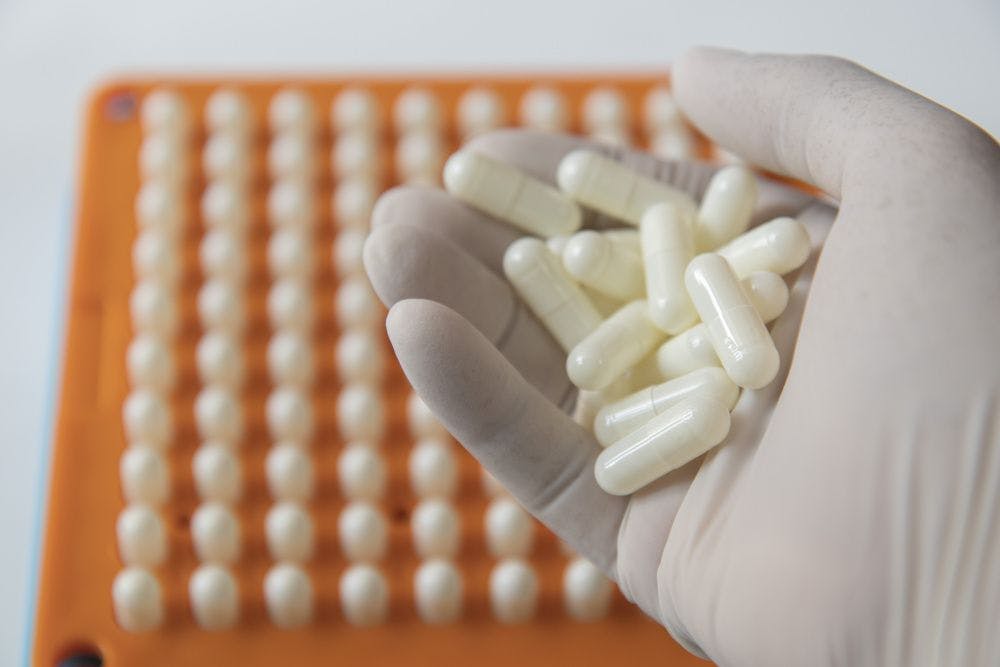Contract manufacturing outlook for dietary supplements in 2021
Contract manufacturers give us the 360-degree view of how manufacturing will look this year amidst a global pandemic, supply-chain obstacles, and unprecedented dietary supplement demand.
Photo © Wp_4289 - Stock.adobe.com

Does anyone really want to be in 2021’s shoes right now? Given the disaster that was 2020, expectations are riding high that this new year will—if not swoop in and save us entirely—at least provide a path forward to…the good-old days? Maybe the relative calm of 2019, please?
While that’s unlikely to happen, those in the dietary supplement contract manufacturing space maintain faith that the coming year will restore some normalcy to the sector and to their individual operations. And if things go right, it may even leave the industry better off than before.
After all, says Eugene Ung, CEO, Best Formulations (City of Industry, CA), “While there’s certainly fatigue with continuing pandemic restrictions, we could be seeing a fundamental shift in consumer habits related to taking control of health—including diet, exercise, stress management, and, of course, nutritional support. Hopefully, there will be a new baseline of dietary supplement use going beyond 2021.”
The COVID Dividend, or Economic Headwinds?
That the COVID-19 pandemic had a salutary effect on dietary supplement sales is now a matter of fact. But industry members can’t help but keep marveling at how fortuitous the turn of events has been.
“We’re still very much in the midst of this pandemic, and people are still concerned about their health,” observes Raj Chopra, CEO, Tishcon (Westbury, NY). “As a result, the number of consumers buying immunity products in 2020 skyrocketed and continues to present a real opportunity for manufacturers.”
Michael Courts, business development product manager, Lief Labs (Valencia, CA), watched this opportunity play out in real time. “Since COVID, we’ve seen a massive increase in manufacturing and product launches to help satisfy consumers looking for products that might boost their immune system, or address deficiencies they’ve discovered,” he says. “And I’m optimistic that these people are going to continue taking care of themselves.”
But what if that looming COVID recession becomes a reality—as it already is for too many consumers?
Terry Keller, vice president of sales, Captek Softgel International (Cerritos, CA), looks to past recessions for proof that businesses in the health-and-wellness space are well-positioned to make it through. “The dietary supplement industry has withstood previous economic slumps better than most consumer product categories,” he points out, “so I don’t see major shifts going forward. However, if this global situation has taught us anything, it’s that our interconnected marketplace is influenced by issues that quickly cross country and regional borders.”
Bad Timing
And how. As Ung notes, “No one can control the macroeconomic picture. But now more than ever, the world is incredibly small and interconnected.”
Industry got a hard lesson in just how interconnected it is when COVID-19 sent supply chains into paroxysms last spring. Ingredient shortages, transportation bottlenecks, and production disruptions of biblical proportion characterized the pandemic’s early months. And while knots in the system are gradually working themselves out, raw-material lines remain “inconsistent and challenging,” Ung says, and “logistics continue to be a risk.”
The upshot is that ingredient prices are rising “across the board,” Ung continues, “and shortages are appearing across a number of major categories, including vitamins, minerals, aminos, and botanicals.” That’s imposed longer lead times on brands and manufacturers alike, which not only wreak havoc on production schedules, he continues, but “make it challenging for brands to respond to market conditions.”
Alas, Yi Li, director of strategic sourcing at Captek, predicts that raw-material price hikes will persist as inflationary pressure on transportation costs, coupled with demand-driven supply deficiencies and even the whims of nature, conjure up the perfect supply-demand storm to keep prices high. Her company continues to contend with long lead times on ingredients coming from India and South America, she says, “and poor harvests on such raw materials as evening primrose oil, pumpkin oil, and olive oil have all led to higher prices.”
For his part, Courts has been monitoring the situation around vitamin C and notes that sources within the industry report tapped-out production capacity among some Chinese producers through the fourth quarter of 2021. “And if you didn’t secure product before,” he warns, “you might not be able to find much vitamin C to help you maintain your current business.”
Botanical supplies may prove equally hard to come by, he goes on. “Farmers only forecast out so far for a defined amount of product based on previous two- to three-year forecasts,” he explains. “So not only is it going to take time to recover the material they were producing and harvesting before; as they expand further they’ll have to make sure they’re developing farming areas so that they can create more product to deliver on increased demand.”
Expect the Unexpected
Savvy contract manufacturers recognize the inevitability of these growing pains and shape their protocols around them. As Chopra says, “We have to be prepared for interruptions and gyrations. Many of the regions we rely on for ingredients still have months, if not years, of pandemic pressure ahead. Slowdowns in the chain are tough to overcome, and the need to adjust quickly is crucial for success.”
Case in point, pandemic-related shipment delays and production hiccups forced Chopra’s crew “more than ever” to “focus on in-depth advance planning and the ability to adapt our processes on the fly to ensure we don’t fall behind,” he says. “We can’t forecast every scenario, but we’ve been strategically planning to avoid major ones.”
As far as Courts sees it, “Everyone in industry’s going to have to start expecting the unexpected—the ‘plan for the worst but hope for the best’ strategy.” Whether facing drought, earthquake, coup, or yet another virus, the drill’s the same, he says: “We need strategies and processes in place beforehand so we can ramp up, change procurement, and update production and delivery procedures to accommodate the huge changes that can happen abruptly.”
Predicting the Future
Anticipation is the name of this new game, and Courts can’t overemphasize the importance of doing due diligence. “We’ve been paying a lot of attention to industry news,” he notes, “and we’ve learned that you have to make sure your director of supply chains is constantly keeping a finger on the pulse of what manufacturers here and abroad are doing to keep up capacity. Ask yourself questions like, ‘Did we go through more material than forecast during the first two quarters, and does this mean we may run short in quarters three and four?’ If so, you may need to procure more supply in advance.”
Asking such questions is par for the course at Soft Gel Technologies (Commerce, CA), says Steve Holtby, president and CEO. In fact, as stay-at-home orders first descended back in March, the company was already contacting raw-material suppliers “to make sure we had our open purchase orders filled and pricing set,” Holtby says—especially in the case of ingredients they encapsulate frequently, like CoQ10. “By anticipating potential shortages in late March and early April,” Holtby continues, “we were able to manufacture without waiting for raw materials.”
Nearly a year into COVID-19, they still know just what to do when an ingredient backlog pops up: “evaluate and qualify other suppliers as backup sources,” Holtby says, adding that to rely on a single supplier for any ingredient is to court catastrophe. “It’s better to have at least three approved suppliers per ingredient,” he advises. “It’s also imperative for ingredient distributors and brokers to diversify their stock of available raw materials, especially extracts.”
Risk and Reward
Yet while single-supplier sourcing is a risk no prudent brand or manufacturer should take, Courts thinks industry would do well to take on an entirely different class of risk—namely, the risk of keeping more inventory on hand than has been the industry norm, whether of ingredients, packaging, or otherwise.
“Nobody wants to take on risk, especially with raw materials that have an expiration date, or even with packaging that may become obsolete as new materials come out,” Courts concedes. “But the risk is necessary, and companies need to start putting in blanket orders that cover these materials for six months to a year, just to anticipate current business, let alone any new business that may come. Those blanket orders help prepare your vendor to supply you with the product you already know you need.”
Ung actually credits the pandemic with revealing weaknesses in the just-in-time model that made efficiency procurement’s sacred bottom line. “For years, companies have preached lean, ‘just-in-time’ inventories,” he says, “and they no doubt provide better cash-flow management. But they leave companies exposed when major supply-chain disruptions occur.”
They occurred last year, and the lesson they taught means that “the pendulum has certainly swung toward stocking some inventory, which we may continue seeing into 2021,” Ung says.
Safety First
Something else we’ll likely see for the foreseeable future: a focus on workplace safety and sanitation that surpasses the strict standards the industry practiced even before COVID-19.
As Holtby points out, while companies in tech and the media could hit the lights and send employees home to work, “manufacturers faced the reality that what we do requires employees to work onsite; there’s no factory production work from home when it comes to manufacturing softgels and other dietary supplements.”
That not only forced companies to adapt under pressure; it underscored the responsibility of contract manufacturers to create the safest possible work environments, too. So in accordance with Centers for Disease Control and Prevention guidelines, Holtby says, Soft Gel encouraged employees to stay home if sick. The company provided face masks to all—and required they be worn at all times—and preached the use of hand sanitizer and disinfecting wipes, handwashing, and physical distancing.
Beyond that, they outfitted high-traffic production areas with signage and floor stickers marking out six-foot distances where possible, and held meetings remotely also when possible. They limited seating in breakrooms and equipped tables with Plexiglass shields, and amped up the frequency and vigor of facility cleanings—wiping down and sanitizing high-touch surfaces, and conducting deep cleanings on weekends. “Employee health and safety remain a top priority,” Holtby concludes.
Relationships Count
As for how contract manufacturers are adapting their facility audit and visit protocols, the way forward seems to be virtual. “We’ve conducted a number of successful virtual audits with customers and industry,” Ung says. And whether or not such audits—“or some sort of hybridized physical and virtual version”—become the norm, both approaches, he says, “have their merits and challenges, for customers and the manufacturer.”
Either way, the pandemic “has really brought relationships and open communication to the forefront amongst brands, manufacturers, and suppliers,” Ung declares. “Companies that were actively communicating beforehand had a better chance of working through issues and challenges, and the importance of solid relationships became obvious. Open, proactive communication and positive relationships typically go hand-in-hand and are critical to navigating these challenging times.”
So, too, adds Courts, are well-managed expectations. When upheavals like COVID-19 arise, “you’re going to hit capacity issues, and you’re not going to be able to expand your facility to satisfy that demand immediately,” he says. “So you need to inform customers from the minute you understand the situation that there might be a capacity issue and that you might not get product in, say, 12 to 16 weeks.”
Of course, the flipside of that is that the customer’s best interest lies in placing orders early and often, so to speak, to ensure a spot on their contract manufacturer’s production schedule and thus a more timely delivery of product. “If you manage your customers’ expectations and do what you can to mitigate anything that could harm them,” Courts says, “everybody’s going to be happy at the end of the day. That’s something a lot of people didn’t do until it smacked them in the face with COVID.”
The More Things Change
In Court’s final analysis, “It’s all about looking at the big picture as far into the future as you can,” he says. And it shouldn’t take a global pandemic to motivate brands or manufacturers to do so; even the introduction of a blockbuster new ingredient or delivery system can shoot demand to such untenable levels that sourcing and production could hit roadblocks. As Courts puts it, “This isn’t all COVID-driven.”
Nor are the bigger-picture trends that contract manufacturers are focusing on as they hope to put 2020 in the rearview mirror. Doug Brown, director, Americas, at Sirio Nutrition (California), expects ingredients like vitamin D, magnesium, zinc, and adaptogenic herbs—he mentions saffron, ashwagandha, echinacea—to go from strength to strength this year. “Plant-based gummies should also continue dominating,” he says, “with more innovation in this space. We’ve already made great advances with the introduction of our center-filled gummy technology that provides consumers a more enjoyable taste and visual experience.”
Ung, too, is betting on gummies, which he says “provide an easy entry point for consumers new to taking dietary supplements. And COVID has certain brought immune health front and center to the masses.”
Yet all supplement sectors didn’t see equal gains last year. “There was certainly a wave of dietary supplement demand in general,” Ung says, “but some categories didn’t ride that wave, such as sports supplements, cannabidiol (CBD), vision products, and more.” His hope: “Some of these lagging categories could see a rebound as we get back to a sense of normalcy.”
Keller predicts that products for sleep enhancement and stress relief will take up more of their production time in COVID-19’s wake, adding that “we’re also curious to see whether or not there will be a re-emergence of CBD-related business, along with some of the anticipated ancillary derivatives of that segment, in the coming year.”
On the broader front, Chopra expects the Biden administration to institute “some positive policy changes” to current tariff structures that should aid the industry—although he concedes that “those changes likely won’t be felt for some time due to more pressing national issues.” Like, for example, eradicating COVID-19.
And Chopra also wagers the shift to online shopping that came with the pandemic won’t likely reverse soon—or perhaps at all. And as more supplement consumers launch their digital migrations, he says, “Our customers have had to adjust their supply chains, warehousing, and distribution operations along with them. As a contract manufacturer, we’ve had to look at our processes, too, and ensure that they’re optimized to serve this growing sales model.”
Finally, Courts observes, “From a production standpoint, I see an environment unfolding that’s even more highly collaborative—and competitive—than it was before COVID.” In other words, as manufacturers reach or exceed their production capacities thanks to continuing demand for wellness, companies like his have “sometimes had to rely on our competitors to help satisfy current customer needs, as well as needs from new customers that have come our way.” The result has been to turn competitors into partners, he says, “so that we can continue to bring these important products to the forefront.”

Prinova acquires Aplinova to further increase its footprint in Latin America
April 7th 2025Prinova has recently announced the acquisition of Brazilian ingredients distributor Aplinova, which is a provider of specialty ingredients for a range of market segments that include food, beverage, supplements, and personal care.

























